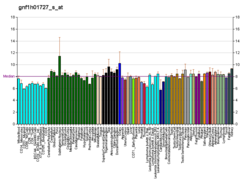
Summary
ADGRV1, also known as G protein-coupled receptor 98 (GPR98) or Very Large G-protein coupled receptor 1 (VLGR1), is a protein that in humans is encoded by the GPR98 gene.[5] Several alternatively spliced transcripts have been described.[5]
| ADGRV1 | |||||||||||||||||||||||||||||||||||||||||||||||||||
|---|---|---|---|---|---|---|---|---|---|---|---|---|---|---|---|---|---|---|---|---|---|---|---|---|---|---|---|---|---|---|---|---|---|---|---|---|---|---|---|---|---|---|---|---|---|---|---|---|---|---|---|
| Identifiers | |||||||||||||||||||||||||||||||||||||||||||||||||||
| Aliases | ADGRV1, FEB4, MASS1, USH2B, USH2C, VLGR1, VLGR1b, GPR98, adhesion G protein-coupled receptor V1 | ||||||||||||||||||||||||||||||||||||||||||||||||||
| External IDs | OMIM: 602851 MGI: 1274784 HomoloGene: 19815 GeneCards: ADGRV1 | ||||||||||||||||||||||||||||||||||||||||||||||||||
| |||||||||||||||||||||||||||||||||||||||||||||||||||
| |||||||||||||||||||||||||||||||||||||||||||||||||||
| |||||||||||||||||||||||||||||||||||||||||||||||||||
| |||||||||||||||||||||||||||||||||||||||||||||||||||
| |||||||||||||||||||||||||||||||||||||||||||||||||||
| Wikidata | |||||||||||||||||||||||||||||||||||||||||||||||||||
| |||||||||||||||||||||||||||||||||||||||||||||||||||
The adhesion GPCR VLGR1 is the largest GPCR known, with a size of 6300 amino acids and consisting of 90 exons.[6] There are 8 splice variants of VlgR1, named VlgR1a-1e and Mass1.1-1.3. The N-terminus consists of 5800 amino acids containing 35 Calx-beta domains, one pentraxin domain, and one epilepsy associated repeat. Mutations of VlgR1 have been shown to result in Usher's syndrome. Knockouts of Vlgr1 in mice have been shown to phenocopy Usher's syndrome and lead to audiogenic seizures.
Function edit
This gene encodes a member of the adhesion-GPCR family of receptors.[7] The protein binds calcium and is expressed in the central nervous system. It is also known as very large G-protein coupled receptor 1 because it is 6300 residues long. It contains a C-terminal 7-transmembrane receptor domain, whereas the large N-terminal segment (5900 residues) includes 35 calcium binding Calx-beta domains, and 6 EAR domains.
Evolution edit
The sea urchin genome has a homolog of VLGR1 in it.[8]
Clinical significance edit
Mutations in this gene are associated with Usher syndrome 2 and familial febrile seizures.[5]
References edit
- ^ a b c GRCh38: Ensembl release 89: ENSG00000164199 – Ensembl, May 2017
- ^ a b c GRCm38: Ensembl release 89: ENSMUSG00000069170 – Ensembl, May 2017
- ^ "Human PubMed Reference:". National Center for Biotechnology Information, U.S. National Library of Medicine.
- ^ "Mouse PubMed Reference:". National Center for Biotechnology Information, U.S. National Library of Medicine.
- ^ a b c "Entrez Gene: GPR98 G protein-coupled receptor 98".
- ^ Sun, JP; Li, R; Ren, HZ; Xu, AT; Yu, X; Xu, ZG (May 2013). "The very large g protein coupled receptor (vlgr1) in hair cells". J Mol Neurosci. 50 (1): 204–14. doi:10.1007/s12031-012-9911-5. PMID 23180093. S2CID 16730555.
- ^ Stacey M, Yona S (2011). AdhesionGPCRs: Structure to Function (Advances in Experimental Medicine and Biology). Berlin: Springer. ISBN 978-1-4419-7912-4.
- ^ Whittakera, Charles A.; Bergerone, Karl-Frederik; Whittlec, James; Bruce, P. (2006). "Brandhorste, Robert D. Burked, Richard O. Hynes. The echinoderm adhesome". Developmental Biology. 300 (1): 252–266. doi:10.1016/j.ydbio.2006.07.044. PMC 3565218. PMID 16950242.
Further reading edit
- Staub E, Pérez-Tur J, Siebert R, et al. (2002). "The novel EPTP repeat defines a superfamily of proteins implicated in epileptic disorders". Trends Biochem. Sci. 27 (9): 441–4. doi:10.1016/S0968-0004(02)02163-1. PMID 12217514.
- Ishikawa K, Nagase T, Suyama M, et al. (1998). "Prediction of the coding sequences of unidentified human genes. X. The complete sequences of 100 new cDNA clones from brain which can code for large proteins in vitro". DNA Res. 5 (3): 169–76. doi:10.1093/dnares/5.3.169. PMID 9734811.
- Nakayama J, Hamano K, Iwasaki N, et al. (2000). "Significant evidence for linkage of febrile seizures to chromosome 5q14-q15". Hum. Mol. Genet. 9 (1): 87–91. doi:10.1093/hmg/9.1.87. PMID 10587582.
- Pieke-Dahl S, Möller CG, Kelley PM, et al. (2000). "Genetic heterogeneity of Usher syndrome type II: localisation to chromosome 5q". J. Med. Genet. 37 (4): 256–62. doi:10.1136/jmg.37.4.256. PMC 1734554. PMID 10745043.
- Nikkila H, McMillan DR, Nunez BS, et al. (2001). "Sequence similarities between a novel putative G protein-coupled receptor and Na+/Ca2+ exchangers define a cation binding domain". Mol. Endocrinol. 14 (9): 1351–64. doi:10.1210/me.14.9.1351. PMID 10976914.
- Wiemann S, Weil B, Wellenreuther R, et al. (2001). "Toward a catalog of human genes and proteins: sequencing and analysis of 500 novel complete protein coding human cDNAs". Genome Res. 11 (3): 422–35. doi:10.1101/gr.GR1547R. PMC 311072. PMID 11230166.
- Skradski SL, Clark AM, Jiang H, et al. (2001). "A novel gene causing a mendelian audiogenic mouse epilepsy". Neuron. 31 (4): 537–44. doi:10.1016/S0896-6273(01)00397-X. PMID 11545713. S2CID 14468960.
- McMillan DR, Kayes-Wandover KM, Richardson JA, White PC (2002). "Very large G protein-coupled receptor-1, the largest known cell surface protein, is highly expressed in the developing central nervous system". J. Biol. Chem. 277 (1): 785–92. doi:10.1074/jbc.M108929200. PMID 11606593.
- Nagase T, Kikuno R, Ohara O (2002). "Prediction of the coding sequences of unidentified human genes. XXII. The complete sequences of 50 new cDNA clones which code for large proteins". DNA Res. 8 (6): 319–27. doi:10.1093/dnares/8.6.319. PMID 11853319.
- Nakayama J, Fu YH, Clark AM, et al. (2002). "A nonsense mutation of the MASS1 gene in a family with febrile and afebrile seizures". Ann. Neurol. 52 (5): 654–7. doi:10.1002/ana.10347. PMID 12402266. S2CID 36357793.
- Ota T, Suzuki Y, Nishikawa T, et al. (2004). "Complete sequencing and characterization of 21,243 full-length human cDNAs". Nat. Genet. 36 (1): 40–5. doi:10.1038/ng1285. PMID 14702039.
- Weston MD, Luijendijk MW, Humphrey KD, et al. (2004). "Mutations in the VLGR1 gene implicate G-protein signaling in the pathogenesis of Usher syndrome type II". Am. J. Hum. Genet. 74 (2): 357–66. doi:10.1086/381685. PMC 1181933. PMID 14740321.
- Bjarnadóttir TK, Fredriksson R, Höglund PJ, et al. (2005). "The human and mouse repertoire of the adhesion family of G-protein-coupled receptors". Genomics. 84 (1): 23–33. doi:10.1016/j.ygeno.2003.12.004. PMID 15203201.
- Fu GK, Wang JT, Yang J, et al. (2005). "Circular rapid amplification of cDNA ends for high-throughput extension cloning of partial genes". Genomics. 84 (1): 205–10. doi:10.1016/j.ygeno.2004.01.011. PMID 15203218.
- Schwartz SB, Aleman TS, Cideciyan AV, et al. (2005). "Disease expression in Usher syndrome caused by VLGR1 gene mutation (USH2C) and comparison with USH2A phenotype". Invest. Ophthalmol. Vis. Sci. 46 (2): 734–43. doi:10.1167/iovs.04-1136. PMID 15671307.
- Kimura K, Wakamatsu A, Suzuki Y, et al. (2006). "Diversification of transcriptional modulation: large-scale identification and characterization of putative alternative promoters of human genes". Genome Res. 16 (1): 55–65. doi:10.1101/gr.4039406. PMC 1356129. PMID 16344560.
External links edit
- GeneReviews/NCBI/NIH/UW entry on Usher Syndrome Type II









